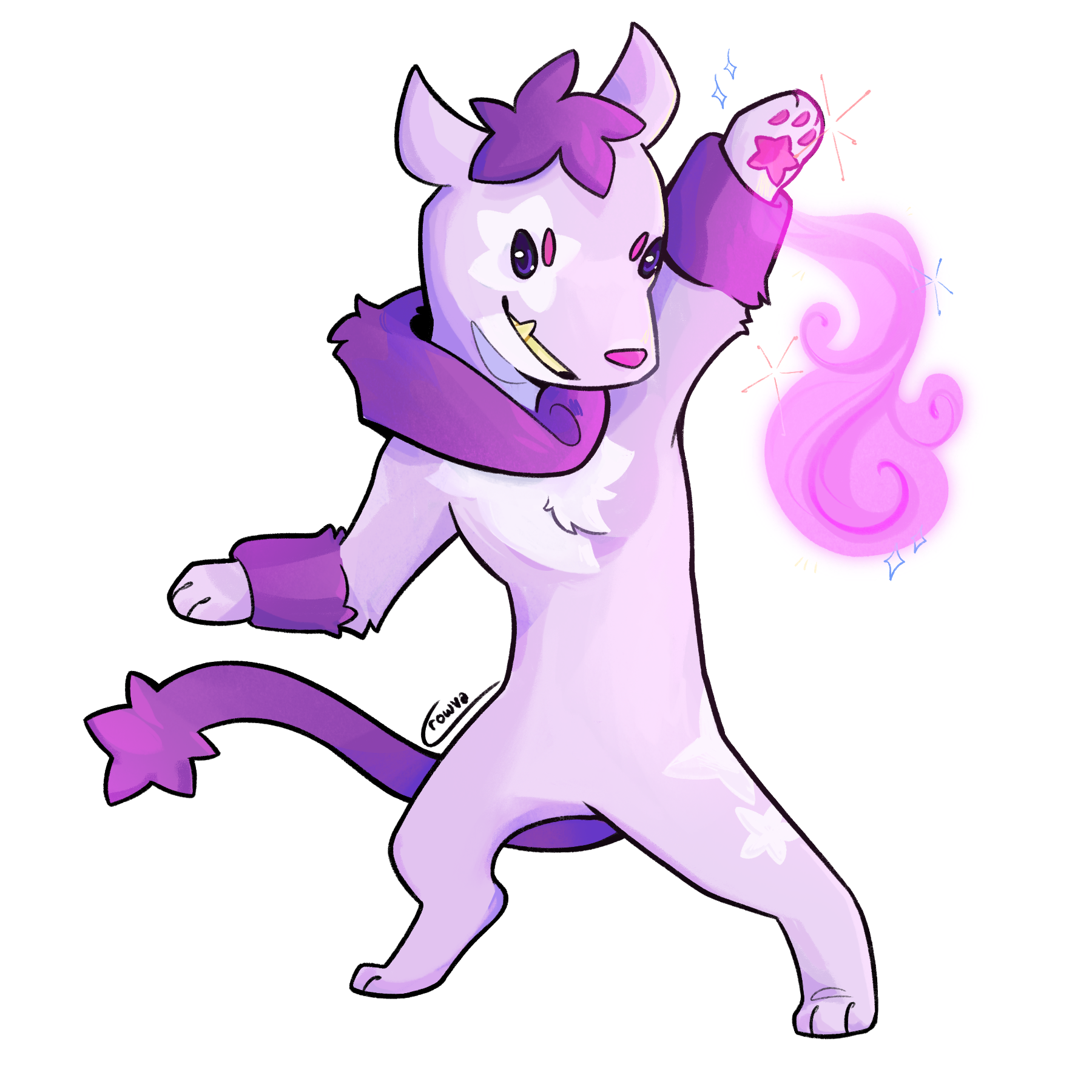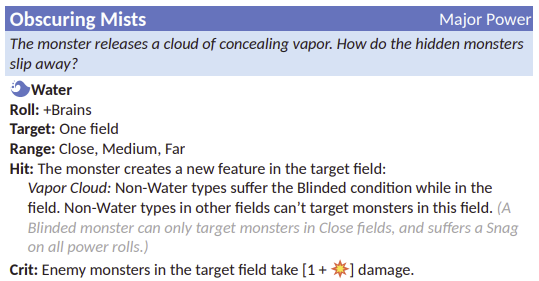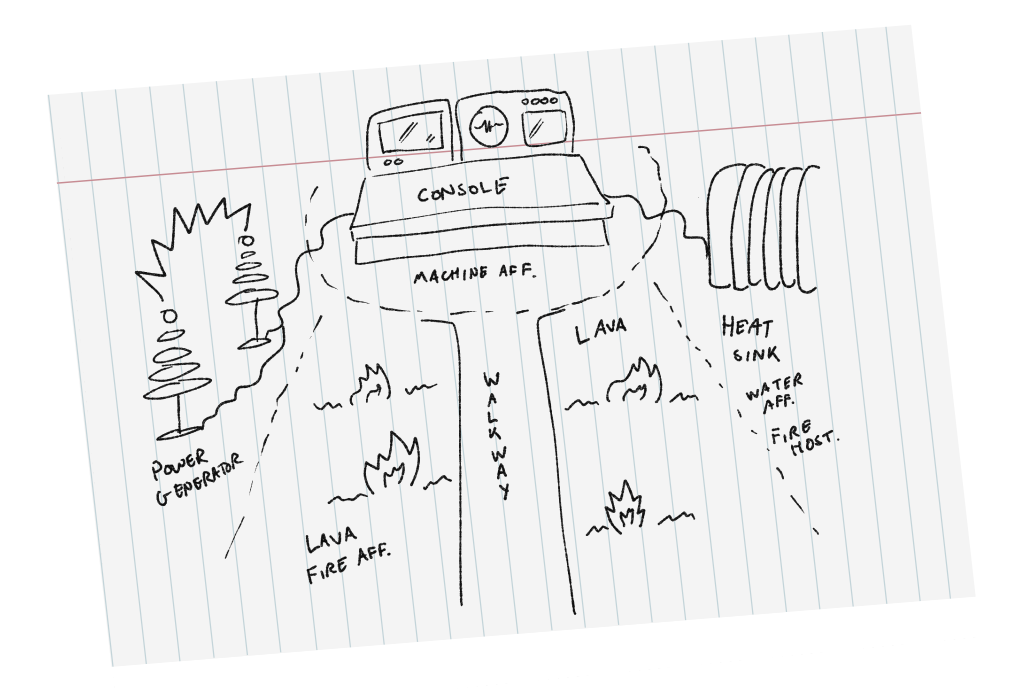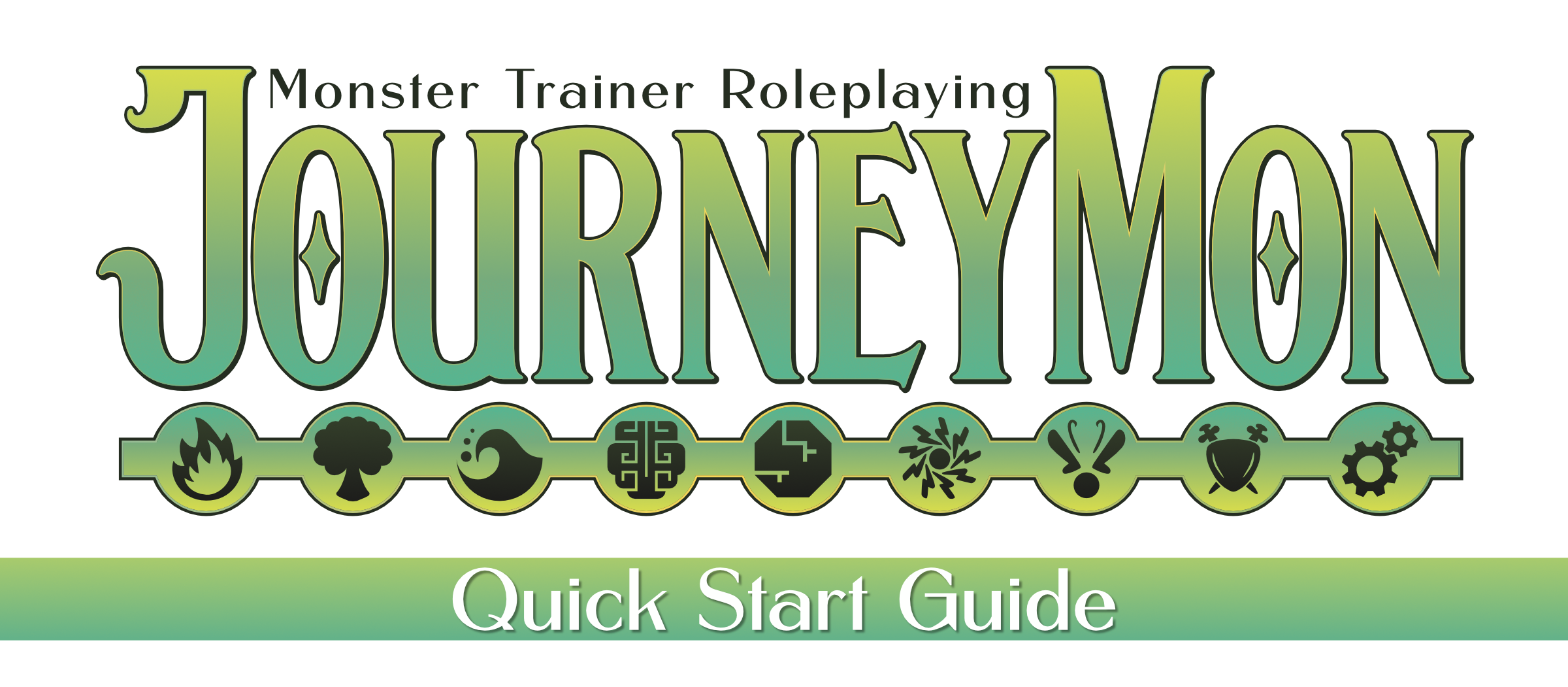JourneyMon Devlog #4: Is JourneyMon PbtA?
JourneyMon is coming soon to
 Follow the campaign here!
Follow the campaign here!
This week’s devlog is one for the TTRPG taxonomists! While I don’t think its particularly useful to draw prescriptive lines around these kinds of things, I did think it’d be fun to talk through some of JourneyMon’s foundations and mechanics in this context. Consider it part fun exercise, part sneaky preview, and part look into my design aims for the game!

Shamink, a Mind-type monster, knows the inner workings of the universe! Art by Juno "Crowva" Kurtin
What is PbtA?
I’m sure many people reading this will be familiar with one or more “Powered by the Apocalypse” TTRPGs. The original is Apocalypse World by Vincent Baker, released way back in 2010. Since Apocalypse World there have been countless variations, many of which I count among my favourite games. Masks: A New Generation and Monster of the Week are probably the pair of PbtA games that inspired me most when putting together JourneyMon’s set of core “Trainer Moves”, which you can see in the Quick Start Guide.
I’ll address the “what is PbtA” question directly by considering which mechanics, design philosophies and themes are common to JourneyMon and many PbtA games, then look at a few ways that I pushed the design outside some usual expectations of these systems.
If you'd like to read about the development, philosophy, and history of PbtA straight from the designer, you can do no better than this article: What is PbtA by Vincent Baker
JourneyMon is PbtA!
Of course JourneyMon is PbtA, I hear some of you cry! It has moves, and playbooks, and 2d6…
And you’d be right! Many of PbtA’s core methods and philosophies are built into JourneyMon. The list below covers some of these, though you can’t really call this a comprehensive list of what PbtA “is” or “should be.”
Cooperative World Building: Many PbtA games task both the players and GMs with developing the world around them during play. That might manifest as a discussion about the nature of peoples' powers, the place they live, or recent history. In JourneyMon, players engage in this kind of world building every session during the "Prologue", creating a region the characters wander to, a monster of the week, and perhaps an NPC to star in the day's Episode.
Reactive Moves: A “Move” might be thought of as the core mechanic of a PbtA game. They are usually reactive rather than proactive: players describe what their characters do, and that might trigger a set of defined moves which might call for a dice roll. Moves are often narrowly defined and target specific storytelling beats. JourneyMon follows this approach for most moves, and especially for its five Trainer Moves: Unleash Your Monster, Act Under Pressure, Make an Impression, Explore, and Show Kindness.
To give an example, a move doesn’t usually start with a player saying “I’d like to use Show Kindness to win over the guard.” Rather, they say “I break off a piece of the cake I baked earlier, wrap it up in a napkin and place it on the counter next to the guard.” At that point, the players and GMs will probably agree you’ve triggered Show Kindness!
Dice Mechanics: Almost every roll of the dice in JourneyMon is 2d6 plus a character’s Aspect. On a 7-9 players can expect a mixed success, and on a 10+ it is a complete success. This system of gradiated success is common to most (but not all) PbtA games. JourneyMon calls a mixed success a “Hit” and a complete success a “Crit”, but its functionally the same system.
Built for Genre: It’s typical of PbtA games to focus narrowly on a particular genre, and even narrowly within genre. The aim there is to develop game mechanics that specifically support the modes of storytelling within those genres, rather than a generalist approach. If something is not addressed mechanically in a PbtA game, it's a clear signal that you aren’t intended to spend much ‘screen time’ dwelling on it. JourneyMon takes this approach too, and focuses on themes of friendship, monster battles, and travel (of sorts) across its moves, playbooks and battles. A good example is perhaps that there is no means for player trainers to take “damage” or “harm” in the traditional sense. Only monsters take damage because in this genre, all conflict is resolved with monsters. Player trainers can get injured, but injury is represented only by its emotional impact (unless you Dive into Battle).
GM Moves: When a character rolls a mixed success or a failure, the GM drives the story forward by making a move of their own. GM moves don’t usually involve dice rolls. Rather, they reveal a danger or add a twist to the scene. In JourneyMon, GM moves are called “Escalations.” Many examples of Escalation are given in the JourneyMon handbook, along with specific ideas for different kinds of villains.
Playbooks: Another common element of PbtA games are “playbooks” that function as part character sheet, part personalised mechanics and advancement for a specific kind of player character. Playbooks are often designed to tell certain stories, guiding a player along a certain genre archetype or character arc. JourneyMon’s playbooks are inspired by characters that appear in many Saturday morning cartoons (like the Ace, Caretaker and Oldtimer) and/or in monster tamer video games (like the Rival, Researcher, and Youngster).

Low/No Prep: “Play to find out” is the rallying cry of many GM-side guides to running a PbtA game. JourneyMon is designed to follow this principle, allowing the GM to come to a session just as excited to make discoveries as the other players. The game’s Prologue is designed to guide the GM and players in setting the stage every session, and the full rulebook includes tips and tables to build a satisfying session in the moment.
JourneyMon is not PbtA!
I have a confession to make—a terrible secret buried beneath two six-sided dice and a printout of basic moves! In reckless pursuit of my aim to emulate the genre, I deviated from many of the common PbtA design elements and philosphies. After all, in this particular space, its important that JourneyMon feels a little bit like a video game!
Structured Battle Scenes: When trainer face off against the villains, and when both command their monsters to engage, it's time for battle! In a nod to the turn-based structure of the roleplaying games that began this genre, JourneyMon’s combat scenes have the option of taking on a more structured kind of storytelling. Players and villains are given chances to take turns to influence the narrative, deciding whether to have their monster companion interact with the battle directly, or whether their trainer should take the focus of that moment of screen time instead.
(Sometimes) Active Moves: Because screen time during combat is handed out to players and NPCs in turn, players might take more consideration of how they can affect the scene mechanically as well as narratively. If a player stages their trainer, they might use their turn to search a battlefield for a useful tool or a way to turn the tide, triggering the Explore move. If they stage their monster instead, they can command their monster to make a special kind of move called a Power. Monster Powers are actively spoken into the narrative rather than triggered reactively. Like in various monster trainer video games and cartoons, the player trainer shouts a command: “Thermanta, use Obscuring Mists! Hide yourself in a vapor cloud!”

NPC Dice Rolls. It’s very common in PbtA systems that even during combat scenes, all dice are rolled by the players rather than the GM. That is, aggressive action is covered by GM moves in response to player moves, or by an “Avoid Danger” move or similar. However, another aspect of JourneyMon’s battles is that GM rolls 2d6 for NPC monster powers, just like the PCs. This only happens during structured battles (not Quick Battles). Though I did try out some mechanics that more closely mirrored other PbtA games in this way, ultimately it felt better in playtesting to go with this symmetric approach. It simply felt more in-genre, and more fun at the table!
Environmental Maps (But Not Grids): Although you can run structured JourneyMon battles entirely in theatre of the mind (with tips to do so in the book), the recommendation is to draw a rough sketch of the locations of key environmental features. This enables tactical play in battles, keeps everyone on the same page as far as staging is concerned, and keeps battles from devolving into a series of back and forth rolls. Players can directly influence the shape and contents of the scene by making the Explore move and using monster Powers in battle, speaking new features into the narrative that can help their friends or hinder their enemies.
So yes, you can find a sprinkler to douse that Matter-type monster!

A sample environment map for a battle in the JourneyMon Quick Start Guide
Conclusions
So is JourneyMon PbtA?
I’ll be honest and say there isn't an actual answer that everyone will agree, but saying “maybe” sounds a bit boring for a conclusion!
Its certainly the case that JourneyMon draws a lot of inspiration from other PbtA games, and as designers we’re always standing on the shoulders of giants. The more structured parts of JourneyMon take inspiration from other games too, including (but not limited to) Blades in the Dark, tactical games like D&D4e, Lancer, and Draw Steel, or narrative fantasy like Daggerheart.
I'd probably land on calling JourneyMon a "PbtA+" game, where its PbtA foundation is complemented by additional mechanical elements designed to target a the battle focus of its genre. That "+" shouldn't be read as implying it is an upgrade, of course! Many PbtA games benefit greatly from steering clear of the "not PbtA" mechanics I listed above!
So... why not download the Quick Start Guide, follow the Kickstarter pre-launch, and take a look at how you’d classify JourneyMon!
Get JourneyMon Quick Start Guide
JourneyMon Quick Start Guide
Monster trainer tabletop roleplaying with collaborative world-building.
| Status | In development |
| Category | Physical game |
| Author | Imogen Gingell |
| Genre | Role Playing |
| Tags | Anime, Monsters, PbtA, Tabletop role-playing game |
More posts
- JourneyMon is LIVE on Kickstarter!4 days ago
- JourneyMon Devlog #6 - Building Mechanical Identities18 days ago
- JourneyMon Launch Date & Villain Preview25 days ago
- JourneyMon Quick Start Booster Packs Out Now!38 days ago
- JourneyMon Devlog #5 - Kill Your Darlings (with Playtests!)60 days ago
- JourneyMon Quick Start Guide - v1.1 Bug Fix66 days ago
- JourneyMon Devlog #3: Seasons of Adventure - Journey Moves88 days ago
- JourneyMon Devlog #2: Designing a Type ChartJul 22, 2025
- Starting our Journey(Mon)Jul 15, 2025

Comments
Log in with itch.io to leave a comment.
Honestly sounds like this may have addressed and dealt with some of the things I dislike about PbtA games, while keeping the bits I find clever and neat. Good job!
Very kind of you to say, thank you! :D